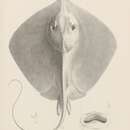pt-BR
nomes no trilho de navegação


Hemitrygon sinensis ist eine Stechrochenart und lebt im nordwestlichen Pazifik vor den Küsten von China und Korea.
Hemitrygon sinensis erreicht eine Gesamtlänge von maximal 82 cm bei bis zu 40 cm Scheibenbreite. Er hat eine rautenförmige Brustflossen-Scheibe, die etwa so breit wie lang ist. Der Schwanz ist peitschenartig, etwas weniger als doppelt so lang wie die Scheibe und trägt meist einen Giftstachel. Die Oberseite ist grau, heller an den Flossenrändern; die Unterseite ist grauweiß.
Über die Lebensweise des Rochens ist wenig bekannt. Er ist vermutlich ovovivipar, wie die meisten Stechrochen. Er wird häufig als Beifang in Schleppnetzen gefangen und vor allem in China auch weiterverwertet.
Die Rochenart wurde im Jahr 1892 durch den deutschen Ichthyologen Franz Steindachner unter der wissenschaftlichen Bezeichnung Trygon sinensis beschrieben, später dann der Gattung Dasyatis zugeordnet. Bei einer Mitte 2016 erfolgten Revision der Dasyatidae wurde die Art in die Gattung Hemitrygon gestellt.[1]
Hemitrygon sinensis ist eine Stechrochenart und lebt im nordwestlichen Pazifik vor den Küsten von China und Korea.
The Chinese stingray, Hemitrygon sinensis, is a little-known species of stingray in the family Dasyatidae, found in the northwestern Pacific Ocean off the coasts of China and Korea. This species is characterized by a band of small dermal denticles running along the upper surface of its diamond-shaped pectoral fin disc, from the snout to the tail spine. It can grow to 40 cm (16 in) across and 82 cm (32 in) long. The Chinese stingray is taken incidentally in bottom trawls and is one of the three most commonly marketed stingrays in China. At present, the International Union for Conservation of Nature (IUCN) has assessed its conservation status as endangered.
The Chinese stingray was originally described as Trygon sinensis by Austrian Franz Steindachner, in an 1892 volume of the scientific journal Denkschriften der Mathematisch-Naturwissenschaftlichen Classe der Kaiserlichen Akademie der Wissenschaften in Wien.[2] The type specimen is a male 38 cm (15 in) across, collected from Shanghai, China.[3]
The Chinese stingray has been recorded along the coasts of China and Korea in the Yellow, Bohai, and East China Seas. Found on or near the bottom, this species apparently inhabits cold, inshore waters less than 200 m (660 ft) deep.[1]
The pectoral fin disc of the Chinese stingray is diamond-shaped and almost as long as wide, with slightly convex leading and trailing margins. The snout is triangular and projecting, comprising a quarter of the disc length. The eyes are of moderate size and closely followed by a pair of spiracles. The mouth is bow-shaped and contains five papillae on the floor, consisting of an anterior row of three and a posterior row of two. The tooth rows number 37 in the upper jaw and 40 in the lower jaw; the teeth of adult males are pointed, while those of juveniles and females are blunt.[2][3]
The whip-like tail measures not quite twice the length of the disc and bears both dorsal and ventral fin folds behind a stinging tail spine; the ventral fold measures less than half as long as the disc.[2][3] Some individuals lack a tail spine.[4] The dorsal surface is roughened by a band of small dermal denticles, extending from the snout to the base of the tail. This species is gray above, lightening to yellowish towards the fin margins, and lighter below.[3] The Chinese stingray attains a disc width of 40 cm (16 in), and a total length of 82 cm (32 in) for males and 73 cm (29 in) for females.[1]
Little is known of the Chinese stingray's natural history.[1] It is presumably aplacental viviparous like other members of its family.[5]
The Chinese stingray is often caught incidentally in bottom trawls along the Chinese coast and marketed for human consumption, though it is of low value. It is one of the three most common stingray species sold in China.[1] This species is subject to intense fishing pressure within its range, but specific utilization or population data is lacking, exacerbated by the difficulty of accurately identifying stingray species. The International Union for Conservation of Nature (IUCN) has listed the Chinese stingray as endangered.[1]
The Chinese stingray, Hemitrygon sinensis, is a little-known species of stingray in the family Dasyatidae, found in the northwestern Pacific Ocean off the coasts of China and Korea. This species is characterized by a band of small dermal denticles running along the upper surface of its diamond-shaped pectoral fin disc, from the snout to the tail spine. It can grow to 40 cm (16 in) across and 82 cm (32 in) long. The Chinese stingray is taken incidentally in bottom trawls and is one of the three most commonly marketed stingrays in China. At present, the International Union for Conservation of Nature (IUCN) has assessed its conservation status as endangered.
Hemitrygon sinensis es una especie de pez de la familia Dasyatidae en el orden de los Rajiformes.
Es un pez de mar y de clima subtropical y demersal.
Se encuentra en el Océano Pacífico noroccidental, en Shanghái (China).
Es inofensivo para los humanos.
Hemitrygon sinensis es una especie de pez de la familia Dasyatidae en el orden de los Rajiformes.
Dasyatis sinensis Dasyatis generoko animalia da. Arrainen barruko Dasyatidae familian sailkatzen da.
Dasyatis sinensis Dasyatis generoko animalia da. Arrainen barruko Dasyatidae familian sailkatzen da.